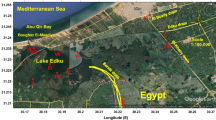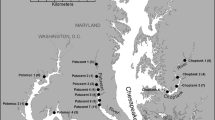Abstract
Phosphorus (P) reactivity and bioavailability in lake sediments may be determined by different forms of P and their distribution. Reactive and nonreactive P pools in two shallow subtropical lake sediments (Lake Apopka and Lake Okeechobee) were determined by sequential chemical extraction using 1 M NH4Cl (pH 7.0), 0.1 M NaOH, and 0.5 M HCl, reportedly representing loosely-bound P, Fe- and Al-bound P, and Ca- and Mg-bound P respectively. The sequential P fractionation was tested using pure P compounds and selected P minerals. The scheme effectively separated Fe- and Al-P from Ca-P fractions in an FePO4-AlPO4-Ca3(PO4)2 mixture. Readily available P, defined as the sum of water-soluble P and NH4Cl-extractable P, in the unconsolidated gyttja (UCG) layer (surface 0–30 cm) of Lake Apopka sediments accounted for 10.1 to 23.7% of total P (TP). This sediment P fraction constitutes a large reservoir which may act as a source of P to the overlying water. In subsurface marl layers (134–148 cm depth) of Lake Apopka, NH4Cl-P constituted <I% of TP whereas Ca-Mg-bound P and highly resistant P (residual P) accounted for 35 and 64% of TP respectively. Results suggest that 1 M NH4Cl (pH 7.0) and 0.5 M HCl, reported to dissolve carbonate-bound P and Ca-Mg-bound P, respectively, may not be extracting distinct pools of P. Lake Okeechobee mud sediments had low concentrations of readily available P (2% of TP) and were dominated by Ca-Mg-bound P (HCl-P≥58% of TP). Sediments in the littoral and peat areas of Lake Okeechobee, however, had high concentrations of readily available P (9.7 and 17.4% of TP respectively); hence, these sediments may play an important role in internal P cycling. The NaOH-P (Fe-Al-P) concentrations for Lake Okeechobee sediments were strongly correlated with amorphous and poorly-crystalline Fe (p< 0.01), suggesting that some P reactions in these sediments may be sensitive to changes in physico-chemical conditions such as redox potential and sediment resuspension.
Similar content being viewed by others
References
Aldridge, F. J., C. L. Schelske & H. J. Hunter, 1993. Nutrient limitation in a hypereutrophic Florida Lake. Arch. Hydrobiol. 127: 21–37.
American Public health Association (APHA). 1992. Standard Methods for the Examination of Water and Wastewater, 18th edn. American Public Health Association, Washington D.C.
Barko J. W. & R. M. Smart, 1980. Mobilization of sediment phosphorus by submersed freshwater macrophytes. Freshwat. Biol. 10: 229–238.
Brezonik, P. L., E. C. Blancher, V. B. Myers, C. L. Hilty, M. K. Leslie, C. R. Kratzer, G. D. Marbury, B. R. Snyder, T. L. Crisman & J. J. Messer, 1979. Factors Affecting Primary Production in Lake Okeechobee, Florida. Report to the Florida Sugarcane League. Report No. 07–79–01. Dept Envir. Eng. Sci., Univ. of Florida, Gainesville.
Brezonik, P. L. & J. L. Fox, 1976. Analysis of Eutrophication and Water Quality Factors in the Middle St. Johns River Basin. Report to the Florida Dept. of Environmental Regulation, Tallahassee, FL.
Burrus, D., R. L. Thomas, J. Dominik & J. P. Vernet, 1990. Seasonal delivery of the particulate forms of phosphorus to Lake Geneva from the upper Rhone River. Aquat. Sci. 52: 221–254.
Canfield, D. E. & M. V. Hoyer, 1988. The eutrophication of Lake Okeechobee. Lake and reservoir management. 4: 91–99.
Chang, S. C. & M. L. Jackson, 1957. Fractionation of soil phosphorus. J. Soil Sci. 84: 133–144.
Fisher, M. M., M. Brenner & K. R. Reddy, 1992. A simple, inexpensive piston corer for collecting undisturbed sediment-water interface profile. J. Paleolimnol. 7: 157–161.
Folsom, B. L. Jr., H. D. Sunderman & L. R. Hossner, 1977. Correcting turbidity interferences in the determination of phosphorus. Soil Sci. Soc. Am. J. 41: 823–824.
Forsberg, C. & S. R. Ryding, 1980. Eutrophication parameters and trophic state indices in 30 Swedish waste receiving lakes. Arch. Hydrobiol. 89: 189–207.
Frink, C. R., 1969. Fractionation of phosphorus in lake sediments: Analytical evaluation. Soil Sci. Soc. Am. Proc. 33: 326–328.
Furumai, H. & S. Ohgaki, 1982. Fractional composition of phosphorus forms in sediments related to release. Wat. Sci. Tech. 14: 215–226.
Golterman, H. L., C. C. Bakels & Jakobs-Mogelin, 1969. Availability of mud phosphates for the growth of algae. Verh. int. Ver. Limnol. 17: 467–479.
Gunatilaka, A., 1988. Estimation of the available P-pool in a large freshwater marsh. Arch. Hydrobiol. Beih. Ergebn. Limnol. 30: 15–24.
Gunatilaka, A., S. Herodek, V. Istvanovics & E. Dobolvi, 1988. Biological availability of sediment phosphorus. Arch. Hydrobiol. Beih. Ergebn. Limnol. 30: 93–98.
Hieltjes, A. H. M. & L. Lijlema, 1980. Fractionation of inorganic phosphates in calcareous sediments. J. envir. Qual. 9: 405–407.
Hosomi, M., M. Okada & R. Sudo, 1981. Release of phosphorus from sediments. Verb. int. Ver. Limnol. 21: 628–633.
Huffman, E. W. D., Jr., 1977. Performance of a new automatic carbon dioxide analyzer. Microchem. J. 22: 567–573.
Klapwijk, S. P., J. M. W. Kroon & M. L. Meijer, 1982. Available phosphorus in lake sediments in The Netherlands. Hydrobiologia 92: 491–500.
Levesque, M. & M. Schnitzer, 1966. Effects of NaOH concentration on the extraction of organic matter and of major inorganic constituents from a soil. Can. J. Soil Sci. 46: 7–12.
McKeague J. A. & J. H. Day, 1966. Dithionite- and oxalateextractable Fe and Al as aids in differentiating various classes of soils. Can. J. Soil Sci. 46: 13–22.
McRoy, C. P., R. J. Barsdate & J. Nebert, 1972. Phosphorus cycling in eelgrass (Zostera marina L.) ecosystem. Limnol. Oceanogr. 17: 58–67.
Mehra, O. P. & M. L. Jackson, 1960. Iron oxide removal from soils and clays by a dithionite-citrate system buffered with sodium bicarbonate. Clays and Clay Minerals 7: 317–327.
Moshi, A. O., A. Wild & J. D. Greenland, 1974. Effect of inorganic matter on the charge and phosphate adsorption characteristics of Kikiyu red clay from Kenya. Geoderma 11: 275–285.
Murphy, J. & J. P. Riley, 1962. A modified single solution method for the determination of phosphate in natural waters. Analyt. Chim. Acta. 27: 31–36.
Ostrofsly, M. L., 1987. Phosphorus species in the surficial sediments of Lakes of Eastern North America. Can. J. Fish. aquat. Sci. 44: 960–966.
Petersen, G. W. & R. B. Corey, 1966. A modified Chang and Jackson procedure for routine fractionation of inorganic phosphates. Soil Sci. Soc. Am. Proc. 30: 563–565.
Pettersson, K., 1986. The fractional composition of phosphorus in lake sediments of different characteristics. In P. G. Sly (ed.), Sediment and Water Interactions. Springer-Verlag: 149–155.
Pettersson, K. & V. Istvanovics, 1988. Sediment phosphorus in Lake Balaton — forms and mobility. Arch. Hydrobiol. Beih. Ergebn. Limnol. 30: 25–41.
Psenner, R., B. Bostrom, M. Dinka, K. Pettersson, R. Pucsko & M. Sager, 1988. Fractionation of phosphorus in suspended matter and sediment. Arch. Hydrobiol. Beih. Ergebn. Limnol. 30: 98–103.
Reddy, K. R., M. Brenner, M. M. Fisher & D. B. Ivanoff, 1991. Lake Okeechobee Phosphorus Dynamics Study: Biogeochemical Processes in the Sediments. Vol. III. Final Report to the South Florida Water Management District. West Palm Beach, FL. Contract No. 531-m88-0445-A4. Soil Science Department, Institute of Food and Agric. Science, University of Florida, Gainesville.
Reddy, K. R. & D. A. Graetz, 1991. Internal nutrient budget for Lake Apopka. Special Publ. SJ91-SP6. St. Johns River Water Mgt District. Palatka, Florida.
SAS Institute Inc., 1985. SAS User's Guide: Statistics, Version 5 Edition, Cary NC: SAS Institute Inc., 1985.
Saunders, W. M. H. & E. G. Williams, 1955. Observations on the determination of total organic phosphorus in soil. J. Soil Sci. 6: 254–267.
Sonzogni, W. C., S. C. Chapra, D. E. Armstrong & T. J. Logan, 1982. Bioavailability of phosphorus inputs to lakes. J. envir. Qual. 11: 555–563.
Syers, J. K., R. F. Harris & D. E. Armstrong, 1973. Phosphate chemistry in lake sediments. J. envir. Qual. 2: 1–14.
Syers, J. K., J. D. H. Williams & T. W. Walker, 1968. The determination of total phosphorus in soils and parent materials. N. Z. J. Agric. Res. 11: 757–762.
Tiren, T. & K. Pettersson, 1985. The influence of nitrate on the phosphorus flux to and from oxygen depleted lake sediments. Hydrobiologia 120: 207–223.
U.S. Environmental Protection Agency (USEPA). 1983. Methods for Chemical Analysis of Water and Wastes. EPA-600/4–79–020. Environmental Monitoring and Support Laboratory, Office of Research and Development, USEPA. Cincinnati, OH.
van Eck, G. T. M., 1982. Forms of phosphorus in particulate matter from the Hollands Diep/Haringvliet, The Netherlands. Hydrobiologia 91: 655–681.
Wang, H., 1990. Mineralogical and chemical characteristics of phosphates in some Florida phosphatic soils. Ph. D. Dissertation. University of Florida.
Wetzel, R. G., 1975. Limnology. W. B. Saunders, Co., Philadelphia, 743 pp.
Watanabe, F. S. & R. S. Olsen, 1961. Colorimetric determination of phosphorus in water extracts of soil. Soil Sci. 93: 183–188.
Wildung, R. E., R. L. Schmidt & R. C. Rouston, 1977. The phosphorus status of eutrophic lake sediments as related to changes in limnological conditions — phosphorus mineral components. J. envir. Qual. 6: 100–104.
Williams, J. D. H., J. K. Syers, S. S. Shukla, R. F. Harris & D. E. Armstrong, 1971. Levels of inorganic and total phosphorus in lake sediments as related to other sediment parameters. Envir. Sci. Technol. 5: 1113–1120.
Author information
Authors and Affiliations
Additional information
Florida Agricultural Experiment Station Journal Series No. R-03406. This work was supported in part by South Florida Water Management District and St. Johns River Water Management District.
Rights and permissions
About this article
Cite this article
Olila, O.G., Reddy, K.R. & Harris, W.G. Forms and distribution of inorganic phosphorus in sediments of two shallow eutrophic lakes in Florida. Hydrobiologia 302, 147–161 (1995). https://doi.org/10.1007/BF00027039
Received:
Revised:
Accepted:
Issue Date:
DOI: https://doi.org/10.1007/BF00027039




